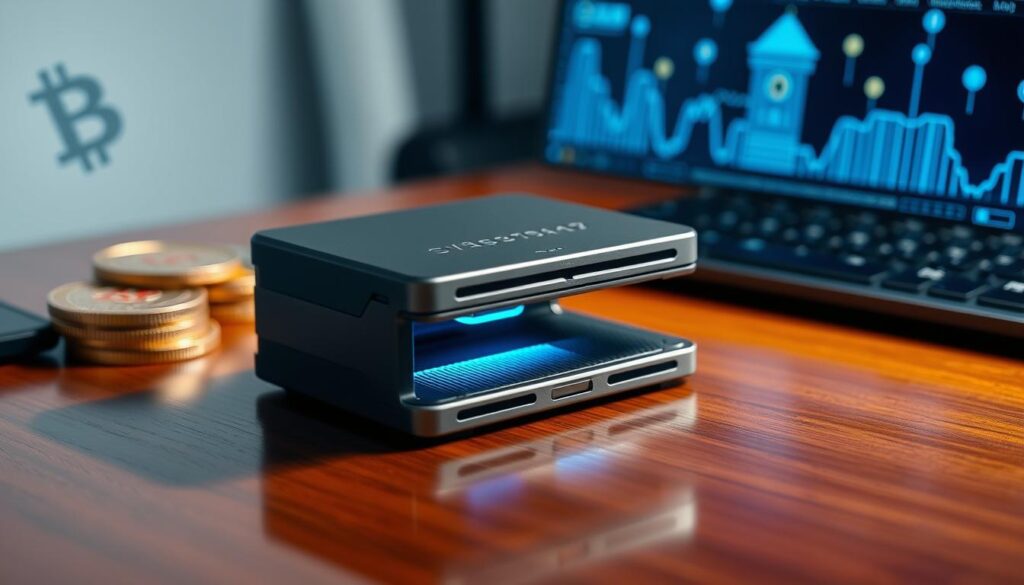With the rise of cryptocurrency, the need for secure storage solutions has become increasingly important. In 2022, the total value of crypto stolen was $3.8 billion, while it decreased to $1.7 billion in 2023. This highlights the importance of prioritizing cryptocurrency security. One of the safest options for crypto storage is a hardware wallet, which provides secure offline storage of private keys, enhancing cryptocurrency security compared to software wallets or exchange storage.
A hardware wallet is a type of cold wallet that ranges in cost from $50 to $250, offering a high level of security for cryptocurrency storage. When selecting a hardware wallet, factors to consider include type of supported coins, user interface, ease of use, price, durability, storage capacity, and additional features. By using a hardware wallet, you can protect your crypto from hacking and other security threats, ensuring the safety of your cryptocurrency investments.
Hardware wallets are recommended for large amounts of cryptocurrency due to their offline security measures. They can be used for basic trading operations, such as securely sending and receiving cryptocurrencies, as well as for advanced activities like staking and lending, with compatible software or browser extensions. By following best practices for hardware wallet management, you can keep your device safe from physical damage and unauthorized access, ensuring the security of your crypto storage.
Table of Contents
Key Takeaways
- Hardware wallets provide secure offline storage of private keys, enhancing cryptocurrency security.
- They are recommended for large amounts of cryptocurrency due to their offline security measures.
- Hardware wallets can be used for basic trading operations and advanced activities like staking and lending.
- Best practices for hardware wallet management include keeping the device safe from physical damage and unauthorized access.
- Cold wallets, including hardware wallets, provide the highest level of security for cryptocurrency storage.
- Hardware wallets range in cost from $50 to $250, offering a high level of security for cryptocurrency storage.
Understanding Hardware Wallets
Hardware wallets are physical devices that securely store private cryptographic keys offline for cryptocurrency transactions, providing a cold storage solution for crypto assets. They are considered more secure than hot wallets because they store private keys offline, reducing the risk of exposure to online threats like malware and phishing attacks.
A hardware wallet is essentially an offline wallet that keeps a crypto user’s private keys in offline or “cold” storage, making it a crypto security device that offers unmatched security against online threats such as hacking and phishing.
What is a Hardware Wallet?
A hardware wallet is a physical device that stores private keys securely, allowing users to manage multiple blockchain addresses and diverse assets from a single device.
How Hardware Wallets Work
Hardware wallets utilize layered security measures, including offline storage of private keys, encrypted PINs, and recovery phrases for asset recovery in case of loss or damage.
Types of Hardware Wallets Available
There are various types of hardware wallets available, including USB devices and Bluetooth-enabled options, each with unique features and use cases. Some popular hardware wallet brands include Trezor and Ledger.
When choosing a hardware wallet, it’s essential to consider factors such as security, usability, and cost. While hardware wallets may come with a significant upfront cost, they offer a balance between safety and usability, making them essential for those serious about protecting their cryptocurrency investments.
Why Hardware Wallets Are Essential for Crypto Security
Hardware wallets are a crucial component in crypto theft prevention, as they provide a secure way to store private keys offline. This offline storage makes them immune to remote attacks and internet hacking resistance. By keeping private keys offline, hardware wallets ensure that even if a computer or device is compromised, the cryptocurrency remains safe.
A key benefit of hardware wallets is their ability to provide private key protection. This is particularly important, as private keys are the most sensitive information in cryptocurrency transactions. With a hardware wallet, users can securely access web services and encrypt passwords, adding an extra layer of security to their digital assets.
Some notable features of hardware wallets include their storage capacity, convenience, and functionality. For example, Trezor hardware wallets have no achievable storage limit, allowing for multiple accounts and currencies under different passphrases. Additionally, hardware wallets like Trezor offer trustless security through offline key storage and are immune to sophisticated physical attacks with a strong passphrase.
In terms of security, hardware wallets have a significantly lower risk of security breaches compared to hot wallets. According to a recent survey, 62% of cryptocurrency investors prefer to use hardware wallets due to their enhanced security features. The following table highlights the key benefits of hardware wallets:
| Feature | Hardware Wallets | Hot Wallets |
|---|---|---|
| Private Key Storage | Offline | Online |
| Security Breach Risk | Lower | Higher |
| Convenience | High | Higher |
Overall, hardware wallets are an essential tool for anyone serious about crypto theft prevention and private key protection. By providing a secure way to store private keys offline and offering advanced security features, hardware wallets are the best choice for protecting digital assets from hacking resistance.
Choosing the Right Hardware Wallet
When it comes to selecting a hardware wallet, there are several factors to consider. The best crypto hardware wallets offer a range of features, including robust security, ease of use, and compatibility with various cryptocurrencies. A thorough wallet comparison is essential to find the one that suits your needs.
Some popular hardware wallet brands, such as Ledger, Trezor, and KeepKey, offer a range of features, including multi-currency support, user-friendly interfaces, and advanced security features. When evaluating these wallets, consider the types of coins supported, user interface, ease of use, price, durability, storage capacity, and extra features like Bluetooth connectivity.
- Security features, such as PIN protection and recovery seed phrases
- Compatibility with various cryptocurrencies
- Ease of use and user interface
- Price and value proposition
By carefully evaluating these factors and considering the features of different hardware wallets, you can make an informed decision and choose the best crypto hardware wallet for your needs.
Initial Setup Process
When it comes to setting up a new hardware wallet, a secure setup is crucial to ensure the safety of your cryptocurrencies. The hardware wallet configuration process typically begins with unboxing and verifying the device’s authenticity. This step is essential to prevent any potential tampering or counterfeit devices. Once the device is verified, you can proceed with the wallet initialization process.
A critical part of the wallet initialization process is generating and recording the recovery seed phrase. This phrase usually consists of 12-24 words and is used to recover your cryptocurrencies in case the device is lost or damaged. It is essential to store the recovery seed phrase securely, such as in a safe or a secure location, to prevent unauthorized access. Additionally, setting up a strong PIN and enabling two-factor authentication (2FA) can add an extra layer of security to your hardware wallet.
Some hardware wallets, such as the Trezor Model T, offer advanced security features like Shamir share backup, which breaks the recovery seed phrase into multiple shares, providing an additional layer of protection against potential theft. Furthermore, creating a passphrase for a hidden wallet can add an extra layer of security, allowing access to different hidden wallets based on the unique passphrase used.
https://www.youtube.com/watch?v=578D9o-DCiM
To ensure a smooth and secure setup process, it is recommended to follow the manufacturer’s instructions and take necessary precautions to protect your device and recovery seed phrase. By doing so, you can enjoy the benefits of a secure and reliable hardware wallet, providing peace of mind for your cryptocurrency investments.
| Hardware Wallet | Price | Features |
|---|---|---|
| Ledger Nano X | $149 | Supports over 5,000 cryptocurrencies, built-in staking features |
| Trezor Safe 3 | $79 | Supports over 8,000 assets, native staking support for ADA |
| ELLIPAL Titan | $169 | Supports 46 blockchains, extensive DeFi and staking features |
How to Store Crypto Safely in a Hardware Wallet
To ensure secure cryptocurrency storage, it’s essential to understand the process of storing crypto in a hardware wallet. This involves a crypto transfer to hardware wallet, which is a straightforward process once you’ve set up your device. When creating your wallet, make sure to double-check the addresses to avoid any potential issues.
A crucial step in securing your wallet is generating a recovery phrase, which serves as a backup in case your device is lost or stolen. This phrase should be stored securely, as it can be used to access your wallet backup and recover your funds. It’s also a good idea to conduct a small test transaction to ensure everything is set up correctly, verifying the transaction on both the device and the blockchain.
Some key considerations for secure cryptocurrency storage include using a reputable hardware wallet, such as Ledger or Trezor, and following best practices for wallet backup and recovery. By taking these steps, you can ensure that your crypto is stored safely and securely, protecting your investment from potential threats.
When it comes to wallet backup, it’s essential to store your recovery phrase in a safe and secure location, such as a fireproof safe or a secure online storage service. This will help protect your wallet backup and prevent unauthorized access to your funds. By following these steps and using a reputable hardware wallet, you can enjoy secure cryptocurrency storage and protect your investment.
Securing Your Recovery Phrase
Securing your recovery phrase is a critical step in protecting your cryptocurrency holdings. This phrase, also known as a seed phrase or mnemonic phrase, is used to restore your wallet in case it is lost, stolen, or damaged. To ensure seed phrase protection, it’s essential to store it in a safe and secure location.
One effective method for crypto backup security is to use a combination of physical and digital storage methods. For physical storage, consider using a fireproof safe or a safe deposit box at a bank. For digital storage, use a password manager with robust encryption to protect your mnemonic phrase storage.
Here are some best practices for securing your recovery phrase:
- Write it down neatly and store it in multiple secure locations
- Use a metal backup solution for enhanced durability
- Avoid digital storage, but if necessary, use a password manager with robust encryption
- Test the restoration process regularly to verify backup accuracy
By following these best practices and using a combination of physical and digital storage methods, you can ensure the security of your recovery phrase and protect your cryptocurrency holdings.
| Storage Method | Security Level | Recommendation |
|---|---|---|
| Physical Storage | High | Use a fireproof safe or safe deposit box |
| Digital Storage | Medium | Use a password manager with robust encryption |
| Metal Backup Solution | High | Use for enhanced durability |
Connecting Your Hardware Wallet to Computers
To ensure secure device connection, it’s essential to follow best practices when connecting your hardware wallet to computers. This includes using official wallet software and verifying USB connections to prevent malware prevention. When connecting your hardware wallet, make sure the computer is free from malware and other potential risks.
A key aspect of hardware wallet connectivity is to use the device’s screen to verify transaction details. This adds an extra layer of security, as you should never enter your PIN or seed phrase on the computer itself. By taking these precautions, you can significantly reduce the risk of your cryptocurrencies being compromised.
Some important tips to keep in mind when connecting your hardware wallet to computers include:
- Only connect your hardware wallet to trusted computers with adequate security measures
- Avoid using public Wi-Fi networks or public computers
- Regularly audit and monitor your wallet activity to detect and address potential security breaches
By following these guidelines and prioritizing secure device connection and malware prevention, you can help protect your cryptocurrencies and ensure a safe and secure hardware wallet connectivity experience.
Managing Multiple Cryptocurrencies
As the crypto market continues to diversify, the need for a multi-currency wallet has become increasingly important. A multi-currency wallet can hold more than one type of digital money, allowing users to keep two, three, or more kinds of crypto. This feature is particularly useful for investors who want to manage a diverse crypto portfolio and store different types of altcoins in a single wallet.
Some popular hardware wallets support a wide range of cryptocurrencies, making it easy to manage a diverse crypto portfolio. These wallets often come with advanced security features, such as state-of-the-art encryption algorithms, to protect users’ assets from tampering and hacking attempts. Additionally, many hardware wallets allow users to store their assets in a non-custodial manner, giving them full control over their private keys.
When it comes to managing multiple cryptocurrencies, it’s essential to consider the use of a multi-currency wallet that can hold various types of digital assets. This can include altcoin storage options, such as cold wallets, which are completely disconnected from the internet and provide an additional layer of security. By using a combination of hot and cold wallets, investors can evaluate different storage scenarios and maintain good password hygiene to protect their private keys.
Best practices for managing multiple cryptocurrencies include using a multi-faceted approach to wallet management, similar to having savings and checking accounts. This can involve using different wallets for various purposes, such as staking or asset categorization. By taking a organized approach to wallet management, investors can easily track their assets and make informed decisions about their diverse crypto portfolio.
Backup Procedures and Recovery Options
Creating a secure crypto backup strategy is essential for protecting your digital assets. A key component of this strategy is wallet recovery, which involves storing your recovery seed phrase in a safe and secure location. This phrase, typically consisting of 12-24 words, is used to restore your wallet in case of loss, theft, or damage.
To ensure the security of your recovery seed phrase, consider splitting it into two or three parts and storing each part in a separate location. This adds an extra layer of protection against unauthorized access. Additionally, you can use a recovery shares scheme, such as a 2-of-3 or 3-of-5 setup, to further enhance security.
When it comes to seed phrase restoration, it’s crucial to test your recovery procedures regularly. This involves using your recovery seed phrase to restore your wallet and verifying that all of your digital assets are still accessible. By testing your recovery procedures, you can ensure that your crypto backup strategy is effective and that you can recover your assets in case of an emergency.
Some best practices for cryptocurrency wallet backups include creating multiple backups, avoiding storing backups online, and using strong encryption for digital backups. It’s also important to regularly update your backups and test recovery from backup to ensure that your strategy is working effectively.
Common Security Mistakes to Avoid
When it comes to crypto security, protection best practices are crucial to prevent crypto security errors and wallet vulnerabilities. Many users fall victim to common mistakes that can lead to significant losses. Some of these mistakes include sharing private keys, using weak PINs, and neglecting software updates.
A significant number of users, approximately 70%, share private keys or recovery phrases, unintentionally compromising the security of their assets. Furthermore, about 65% of users ignore wallet updates, leaving their funds exposed to security vulnerabilities. To avoid these crypto security errors, it is essential to follow protection best practices such as using strong, unique passwords and keeping software up to date.
Here are some common security mistakes to avoid:
- Using unsecured networks, which can compromise login credentials and transaction details
- Relying solely on hot wallets, which are exposed to cyberattacks and phishing schemes
- Failing to update wallet software, increasing vulnerability to security flaws and potential exploits
By being aware of these common security mistakes and taking steps to avoid them, users can significantly reduce the risk of wallet vulnerabilities and crypto security errors. It is essential to prioritize protection best practices and stay informed about emerging threats and best practices in crypto security.
| Mistake | Consequence | Prevention |
|---|---|---|
| Sharing private keys | Unauthorized access and transfer of funds | Use strong, unique passwords and keep them confidential |
| Using weak PINs | Easy access to wallet and funds | Use strong, unique PINs and keep them confidential |
| Neglecting software updates | Vulnerability to security flaws and potential exploits | Regularly update wallet software and keep it up to date |
Maintaining Your Hardware Wallet
Regular wallet maintenance is crucial to ensure the security and functionality of your hardware wallet. This includes checking for firmware updates regularly, as these updates often include critical security patches that protect your device from potential vulnerabilities.
Proper device care is also essential to maintain the longevity of your hardware wallet. This includes storing the device in a dry, safe place away from high temperatures, humidity, and strong magnetic fields. By following these best practices, you can ensure your hardware wallet remains a secure and reliable storage solution for your cryptocurrencies.
Some key considerations for wallet maintenance include:
- Regularly checking for firmware updates
- Storing the device in a safe and secure location
- Avoiding exposure to extreme temperatures, humidity, and magnetic fields
By prioritizing device care and staying on top of firmware updates, you can help protect your hardware wallet and the valuable assets it stores.
| Best Practice | Description |
|---|---|
| Regular Firmware Updates | Ensure your device has the latest security patches and features |
| Safe Storage | Store your device in a dry, secure location to prevent physical damage |
Emergency Access Planning
Planning for crypto inheritance and wallet access contingency is crucial for ensuring that your digital asset legacy is protected. This involves creating a plan for loved ones to access your crypto assets in case of incapacitation or death.
A secure plan for emergency access can provide peace of mind, knowing that your digital assets are safe and can be accessed when needed. This can be achieved through the use of secure digital vaults, multi-signature setups, and other methods that balance security and accessibility.
Some key considerations for emergency access planning include:
- Securely storing private keys and recovery phrases
- Creating a backup and recovery plan
- Setting up a wallet access contingency plan
By taking the time to plan for emergency access, you can ensure that your digital asset legacy is protected and that your loved ones can access your crypto assets when needed.
| Method | Description |
|---|---|
| Secure Digital Vaults | A secure online storage solution for private keys and recovery phrases |
| Multi-Signature Setups | A setup that requires multiple signatures to access crypto assets |
Advanced Security Features
For users seeking to maximize their security, advanced features such as passphrases and multi-signature setups can provide enhanced wallet security. A passphrase, also known as the “25th word,” adds an extra layer of security to the standard seed phrase, making it more difficult for unauthorized parties to access the wallet. This advanced protection measure can be particularly useful for individuals and organizations storing large amounts of cryptocurrency.
Another key feature is crypto multi-sig, which requires multiple private keys to authorize transactions. This setup can be implemented with hardware wallets, providing an additional layer of security against unauthorized transactions. By using multi-sig wallets, users can ensure that their funds are protected even if one of the private keys is compromised.
- Improved protection against hacking and unauthorized access
- Enhanced security for large amounts of cryptocurrency
- Increased control over transaction authorization
By implementing these advanced protection measures, users can enjoy enhanced wallet security and peace of mind when storing their cryptocurrency. Whether using passphrases or multi-sig setups, these features can provide an additional layer of security against potential threats.
| Security Feature | Description |
|---|---|
| Passphrase | Additional word or phrase added to the standard seed phrase for extra security |
| Multi-sig | Requires multiple private keys to authorize transactions |
Traveling with Your Hardware Wallet
When traveling with a hardware wallet, crypto travel security is a top priority. It’s essential to consider international wallet use and border control considerations to avoid any issues during your trip. One of the primary concerns is the risk of loss or theft, which can be mitigated by taking necessary precautions such as keeping your wallet in a safe place and being mindful of your surroundings.
Another crucial aspect to consider is the border control considerations when traveling with a hardware wallet. It’s vital to understand the regulations and laws regarding cryptocurrency in the countries you plan to visit. Some countries may have specific requirements or restrictions on carrying cryptocurrency, so it’s essential to research and comply with these regulations to avoid any issues.
Here are some tips for traveling with a hardware wallet:
- Keep your wallet in a safe and secure location
- Be mindful of your surroundings and avoid using public Wi-Fi for transactions
- Consider using a software wallet for transactions when traveling
- Set up a backup hardware wallet at home in case the primary wallet is lost or stolen
Additionally, it’s crucial to ensure that your hardware wallet is properly secured before traveling. This includes keeping your firmware up to date, backing up your recovery seed phrase, and using strong passwords and security features like PINs and passphrases.
By following these tips and taking the necessary precautions, you can ensure a safe and secure trip with your hardware wallet. Remember to always prioritize crypto travel security and international wallet use to protect your assets and avoid any issues during your travels.
| Country | Cryptocurrency Regulations |
|---|---|
| United States | Cryptocurrency is considered property and subject to tax |
| European Union | Cryptocurrency is considered a digital asset and subject to regulation |
What to Do If Your Hardware Wallet is Lost or Stolen
If you find yourself in a situation where your hardware wallet is lost or stolen, it’s essential to act quickly to minimize potential damage. A lost wallet protocol should be initiated immediately to prevent any unauthorized access to your crypto funds. In the event of a stolen crypto device, it’s crucial to follow a wallet compromise response plan to protect your assets.
First, attempt to locate the device and assess the situation. If you’re unable to recover your hardware wallet, prepare for recovery by gathering necessary information, such as your seed phrase and PIN. It’s recommended to purchase hardware wallets directly from the manufacturer, as this can help prevent potential scams and ensure you receive a genuine product.
Immediate Action Steps
- Contact the manufacturer’s support team for guidance on the recovery process
- Follow the manufacturer’s instructions for factory resetting the unused hardware wallet
- Initialize a new hardware wallet and generate a new seed phrase
In the event of a lost or stolen hardware wallet, it’s vital to perform a key replacement to reestablish the proper operational security of a multisig setup. This can be done by following a step-by-step guide provided by the manufacturer or by contacting their support team for assistance. Remember to keep your seed phrase and PIN secure, as sharing this information with anyone can lead to potential scams.
| Hardware Wallet Brand | Recovery Process |
|---|---|
| Trezor | Follow the manufacturer’s instructions for factory resetting and initializing a new device |
| Ledger | Use the manufacturer’s guide for setting up a new hardware wallet and generating a new seed phrase |
By following these steps and staying informed about the latest security measures, you can protect your crypto assets and minimize the risk of loss in the event of a lost or stolen hardware wallet. Always prioritize your wallet’s security and take immediate action if you suspect any compromise.
Conclusion
Throughout this comprehensive guide, we’ve explored the vital importance of utilizing hardware wallets to safeguard your cryptocurrency holdings. From understanding the inner workings of these secure devices to implementing best practices for managing your digital assets, the insights provided aim to empower you to take control of your crypto security.
Hardware wallets have emerged as the gold standard for secure storage of cryptocurrencies, offering unparalleled protection against hacks, theft, and loss. By keeping your private keys offline and isolated from potential threats, these specialized devices significantly reduce the risks associated with web-based or mobile wallets. As we’ve discussed, the benefits of hardware wallets include enhanced security features, backup options, and compatibility with a wide range of digital assets.
As you continue your journey into the world of cryptocurrency, remember that hardware wallets are an essential tool for safeguarding your valuable digital investments. By following the strategies outlined in this guide and staying vigilant about your crypto security, you can enjoy the peace of mind that comes with knowing your assets are protected.
FAQ
What is a hardware wallet?
A hardware wallet is a physical device designed to securely store cryptocurrency private keys offline, providing a high level of protection against hacking and theft.
How do hardware wallets work?
Hardware wallets use secure elements and offline transaction signing to keep private keys away from Internet-connected devices, significantly reducing the risk of compromise.
What types of hardware wallets are available?
Hardware wallets come in various forms, including USB devices and Bluetooth-enabled options, each with unique features and use cases.
Why are hardware wallets essential for crypto security?
Hardware wallets address the vulnerabilities of other storage methods by keeping private keys offline and requiring physical confirmation for transactions, protecting against hacks and theft.
How do I choose the right hardware wallet for my needs?
When selecting a hardware wallet, consider factors such as security features, ease of use, supported cryptocurrencies, and price to find the best option for your requirements.
How do I set up a new hardware wallet?
The setup process involves unboxing the device, verifying its authenticity, creating a new wallet, and properly generating and recording the recovery seed phrase.
How do I store cryptocurrencies securely in a hardware wallet?
To store crypto safely, you’ll need to create individual wallets for different cryptocurrencies, generate and securely store the recovery phrase, and conduct a small test transaction to ensure everything is set up correctly.
How do I secure my hardware wallet’s recovery phrase?
Securing your recovery phrase is crucial. Options include physical storage methods, such as writing it down or using metal seed storage devices, as well as creating encrypted digital backups.
How do I safely connect my hardware wallet to computers for transactions?
When connecting your hardware wallet to a computer, it’s essential to use official wallet software, verify the USB connection, and never enter your PIN or seed phrase on the computer itself.
How can I manage multiple cryptocurrencies with a hardware wallet?
Hardware wallets often support a wide range of cryptocurrencies, allowing you to organize and monitor your diverse crypto portfolio. You can add new coins as needed and keep your firmware up-to-date.
How do I backup and recover my hardware wallet?
Regularly backing up your hardware wallet and testing the recovery process is crucial. This includes creating secure offsite backups of your recovery phrase and occasionally performing test recoveries.
What common security mistakes should I avoid with a hardware wallet?
Key security mistakes to avoid include sharing private keys, using weak PINs, falling for phishing attacks, and neglecting software updates. Understanding these pitfalls can help you maintain robust security practices.
How do I properly maintain my hardware wallet?
Maintaining your hardware wallet involves regularly checking for and installing firmware updates, protecting the device from environmental factors, and handling it carefully to prevent physical damage.
How do I plan for emergency access to my crypto assets?
Creating a plan for loved ones to access your cryptocurrency holdings in case of incapacitation or death is crucial. This may involve secure information sharing, legal services, or multi-signature setups.
What advanced security features are available for hardware wallets?
Hardware wallets often offer advanced security features, such as passphrases (the “25th word”) and multi-signature setups, which can provide an additional layer of protection for your crypto assets.
How do I safely travel with my hardware wallet?
When traveling with a hardware wallet, it’s important to follow best practices for packing and transporting the device, use secure internet access, and be aware of legal considerations around large crypto holdings.
What should I do if my hardware wallet is lost or stolen?
If your hardware wallet is lost or stolen, it’s crucial to act quickly. This involves attempting to locate the device, preparing to use your recovery seed, and potentially moving your funds to a new wallet if the PIN is compromised.









